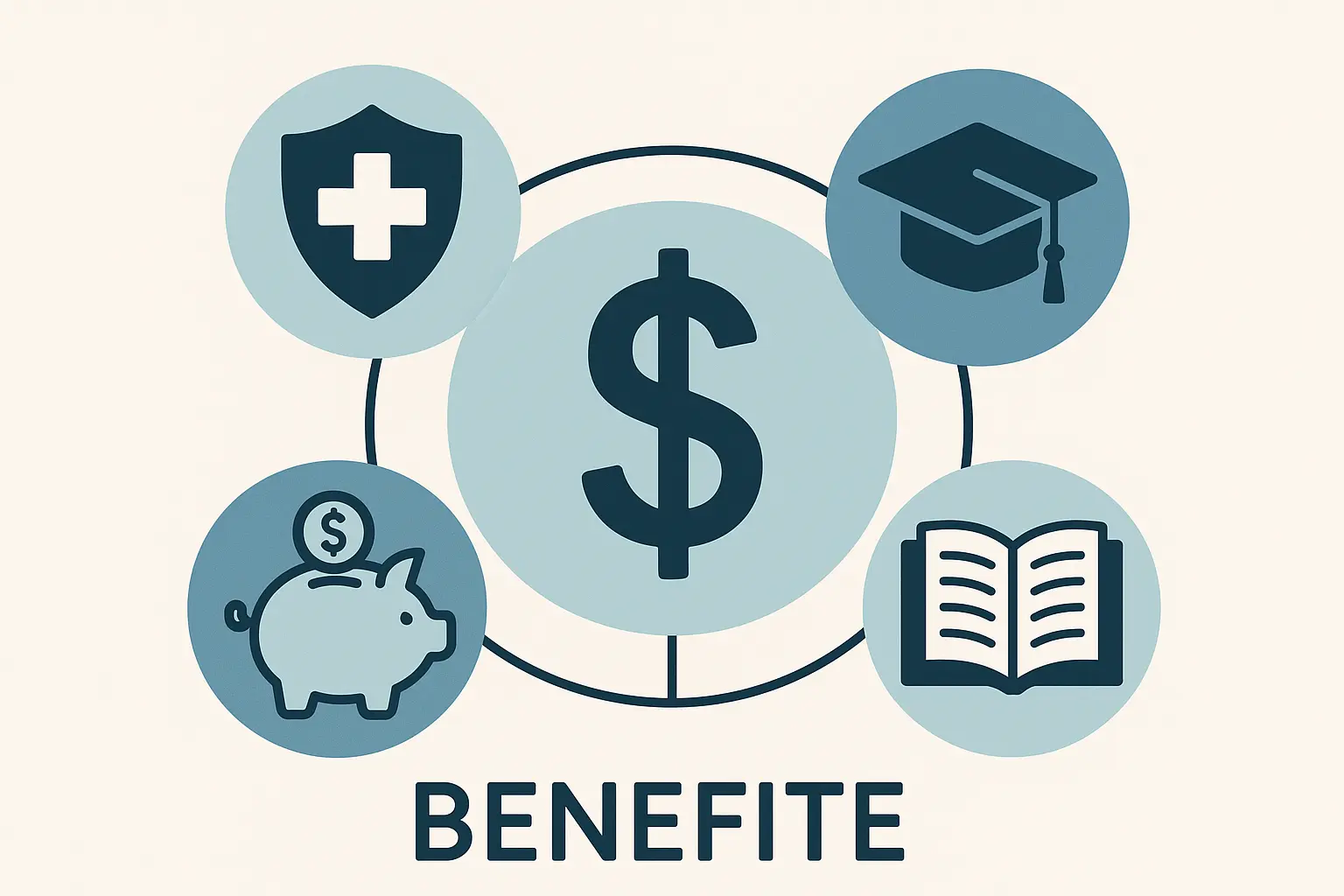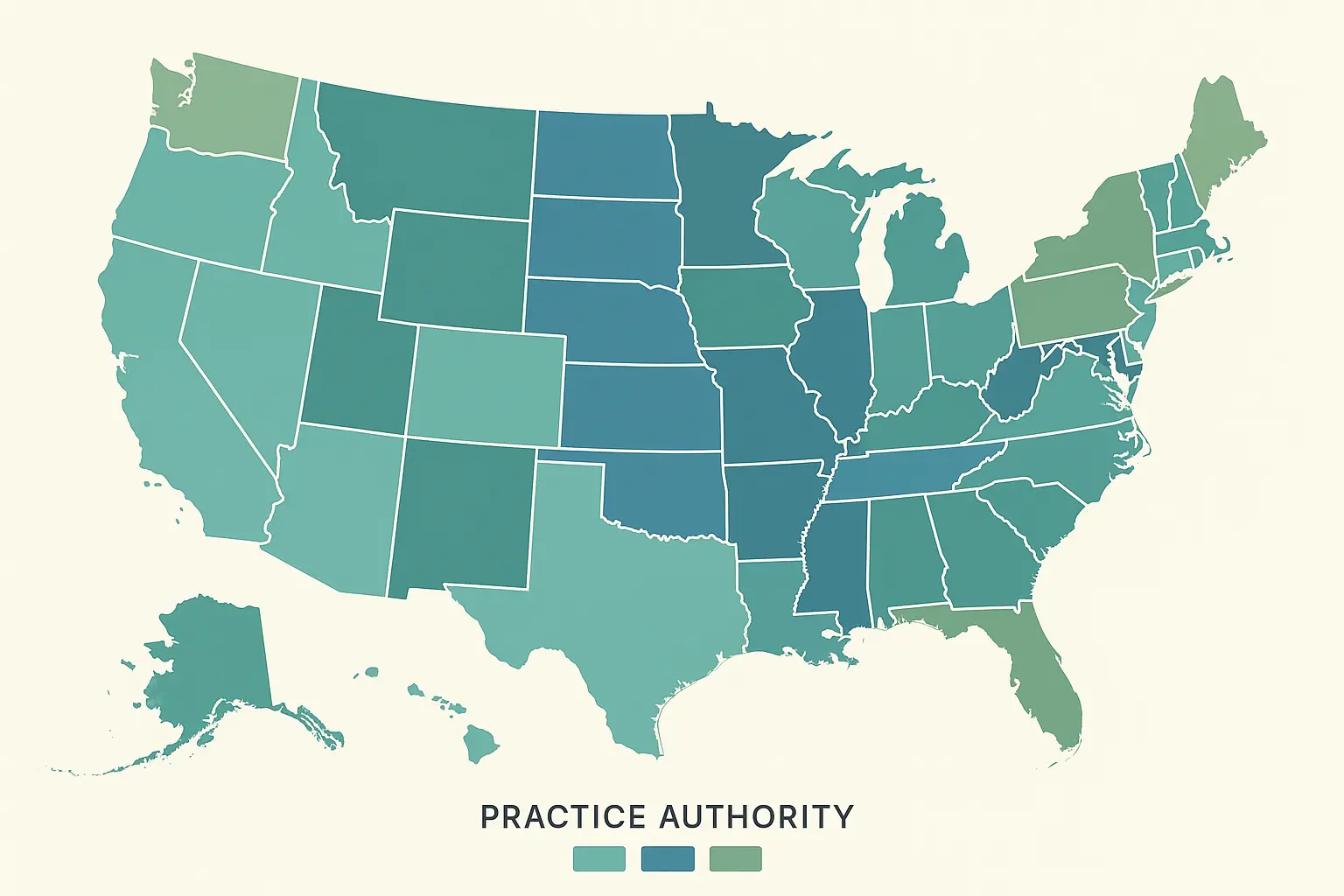Nurse Practitioner Salary: What I Wish Someone Had Told Me Before My First Job Offer

The NP field is absolutely booming right now. Employment is projected to grow 35 percent from 2024 to 2034, way faster than most other jobs according to the Bureau of Labor Statistics. This explosive growth creates incredible opportunities, but it also means a lot of confusion about what you should actually expect to earn. Understanding the real nurse practitioner salary landscape is the first step in making smarter career decisions.
When I first started looking at NP positions, I made every rookie mistake in the book. I focused only on base salary numbers, completely ignored cost-of-living differences, and walked into my first salary negotiation like a deer in headlights. The result? I probably left $15,000 on the table during my first job offer.
Table of Contents
- Understanding the Real Numbers Behind NP Compensation
- Why Your Location Matters More Than You Think
- Specialty Choices That Actually Pay Off
- The Art of Getting What You’re Worth
- Where You Work Changes Everything
- What’s Coming Next for NP Salaries
- How Resume Builder IQ Fits Into Your Salary Strategy
- Final Thoughts
TL;DR
- Base salary is just 70-80% of your total compensation – benefits and bonuses matter
- Geographic location creates salary differences of $40,000+ between states
- Psychiatric mental health and acute care NPs earn the highest salaries
- NPs who negotiate earn 15-25% more than those who don’t
- Full practice authority states typically pay 8-12% more
- DNP preparation can increase earnings by 8-12% over master’s degrees
- Hospital employment often pays 10-15% more than private practice initially
Understanding the Real Numbers Behind NP Compensation
Here’s what I wish someone had told me upfront: That nurse practitioner salary number on the job posting? It’s not the whole story. Not even close.
Your total compensation package includes performance bonuses, benefits, and incentives that can add tens of thousands to your annual earnings. I learned this the hard way when I compared two job offers based only on their advertised salaries. The “lower-paying” position actually offered $18,000 more in total value once I factored in their comprehensive benefits package and quarterly bonuses.
Most people make the same mistake I did – they fixate on that base number and miss the bigger picture. Understanding how hospitals and clinics actually structure pay helps you make smarter career decisions and avoid leaving money on the table like I did.
What You’ll Actually Take Home
When I started looking at NP positions, I made the classic mistake of comparing base salaries without considering everything else. Your base pay typically represents only 70-80% of what you’ll actually receive, with the remaining 20-30% coming from various other compensation components.
This becomes crucial when you’re comparing job offers or trying to understand your true earning potential. When comparing offers, always ask what the total nurse practitioner salary package includes beyond just the base pay. I’ve watched colleagues turn down positions that would have paid them significantly more because they didn’t know how to evaluate the complete package.
The question “how much does a nurse practitioner make” becomes much more complex when you realize that two NPs in identical roles can have vastly different total compensation based on how well they understood their benefits packages.
Base Pay vs. Your Complete Package
Most job postings advertise base salary, but your actual compensation extends far beyond that number. Performance bonuses, productivity incentives, and comprehensive benefits packages can add $15,000-$30,000 annually to your total compensation.
Smart NPs learn to evaluate the complete package rather than fixating on base salary alone. Understanding compensation structures becomes even more critical when you’re preparing for salary negotiations and raise requests, as you’ll need to articulate your value beyond just base salary expectations.
| Compensation Component | Typical Value | Annual Impact |
|---|---|---|
| Base Salary | $100,000-$150,000 | Primary income |
| Performance Bonuses | 5-15% of base | $5,000-$22,500 |
| Health Benefits | $15,000-$25,000 value | Tax savings |
| Retirement Match | 3-6% of salary | $3,000-$9,000 |
| Continuing Education | $2,000-$5,000 | Professional growth |
| Malpractice Coverage | $3,000-$8,000 value | Risk protection |
NPs who understand these compensation components make significantly better career decisions. I’ve watched colleagues accept positions with lower base salaries that ended up paying them more annually because they recognized the value in comprehensive benefits packages.
Each NP needs to evaluate these components based on their personal situation. A young provider might prioritize continuing education funds and career development opportunities, while an experienced NP might focus more on retirement matching and health benefits.
Performance Bonuses That Actually Matter
More hospitals are tying compensation to performance metrics, patient satisfaction scores, and productivity measures. These bonuses aren’t just nice-to-haves – they can boost your income by 10-25% annually.
Understanding how these systems work helps you maximize your earning potential while providing excellent patient care. I’ve seen NPs earn an additional $20,000 annually by understanding their organization’s bonus structure and aligning their practice accordingly.
The most successful providers I know treat these performance metrics as opportunities rather than burdens. They understand that improving patient outcomes and satisfaction scores directly translates to higher compensation.
The Hidden Value in Your Benefits Package
Healthcare benefits, retirement matching, continuing education allowances, and malpractice coverage represent significant financial value that many NPs overlook. When you factor in health insurance premiums, retirement contributions, and professional development funds, these benefits can easily add $15,000-$30,000 to your annual compensation.
I once calculated that my employer’s health insurance plan saved me $18,000 annually compared to purchasing similar coverage independently. Their retirement matching added another $6,000, and the continuing education allowance covered my certification maintenance costs completely.
Why Your Location Matters More Than You Think
Location is hands down the biggest factor in determining your nurse practitioner salary, with differences that can exceed $40,000 between the highest and lowest-paying states. But here’s the kicker – high salaries don’t always translate to better financial outcomes when you factor in cost of living, taxes, and quality of life.
I learned this lesson when I received job offers in both California and Texas. The California position offered $35,000 more in base salary, but after calculating state taxes, housing costs, and general living expenses, the Texas position actually provided better financial outcomes.
Geographic salary variations reflect complex market dynamics including scope of practice laws, healthcare demand, and regional economic conditions. NPs who understand these factors can make strategic location decisions that significantly impact their lifetime earnings.
States Where NPs Actually Make Bank
California, Alaska, Hawaii, Massachusetts, and New York consistently offer the highest NP salaries, often exceeding $130,000 annually. However, these numbers need context – a $140,000 salary in San Francisco doesn’t stretch as far as $110,000 in Austin, Texas.
According to Nurse.org data, nurse practitioners earn an average annual salary of $129,210 per year, with significant state variations ranging from California’s $173,190 to Tennessee’s $108,180 – a difference of over $65,000 annually.
Smart salary evaluation requires looking beyond the raw numbers. The NP who earns $120,000 in a low-cost state might have more disposable income than one earning $160,000 in an expensive metropolitan area. Every provider considering relocation should calculate their real purchasing power, not just their gross salary.
| State | Average NP Salary | Cost of Living Index | Adjusted Value |
|---|---|---|---|
| California | $173,190 | 138.5 | $125,100 |
| Texas | $130,930 | 91.5 | $143,100 |
| Tennessee | $108,180 | 88.7 | $122,000 |
| New York | $148,410 | 125.2 | $118,500 |
| Florida | $128,340 | 99.0 | $129,600 |
Consider Sarah, an FNP who received offers in San Francisco ($165,000) and Austin ($125,000). After factoring in California’s 13.3% state tax, $3,500 monthly rent versus $1,800 in Austin, and higher living costs, her Austin position provided $8,000 more in disposable income annually despite the lower base salary.
Rural Opportunities That Might Surprise You
Rural healthcare facilities often offer compelling compensation packages to attract NPs, including loan forgiveness programs, housing assistance, and higher base salaries. When you factor in lower living costs and additional benefits, rural positions sometimes provide better overall financial outcomes than urban roles.
I know NPs who moved to rural communities and saw their quality of life improve dramatically while maintaining competitive salaries. These positions often offer greater clinical autonomy, stronger community connections, and unique benefits that urban practices can’t match.
Specialty Choices That Actually Pay Off
Your specialty choice significantly impacts earning potential, with some areas commanding 20-50% higher salaries than general family practice roles. Understanding which specialties are in highest demand helps you make strategic career decisions that align with both your interests and financial goals. For example, psychiatric mental health roles often command the highest nurse practitioner salary levels in the country.
The NP specialty market has evolved rapidly, with certain areas experiencing critical shortages that drive up compensation. Mental health, acute care, and emergency specialties consistently command premium salaries due to workforce shortages and specialized skill requirements.
I’ve watched colleagues increase their earning potential by $25,000-$40,000 annually by transitioning to high-demand specialties. The investment in additional training and certification typically pays for itself within the first year through higher compensation.
Psychiatric Mental Health: The Premium Specialty
Data from Bureau of Labor Statistics shows PMHNP salaries vary by state, ranging from Idaho’s highest at $205,080 annually to Montana’s lowest hourly rate of $32.65, demonstrating the significant earning potential in psychiatric specialties.
The mental health crisis has created unprecedented demand for psychiatric NPs, driving salaries well above general practice levels. Many healthcare systems offer signing bonuses, loan forgiveness, and premium compensation packages to attract qualified PMHNPs.
The psychiatric specialty offers unique advantages beyond higher compensation. PMHNPs often have more flexible scheduling options, opportunities for private practice, and the satisfaction of addressing critical healthcare needs in their communities.
Acute Care and Emergency Specialties
Acute care and emergency NPs command premium salaries due to the high-stress environment and specialized skills required. These roles often include shift differentials and overtime opportunities that can significantly boost total compensation.
Michael, an acute care NP at a Level 1 trauma center, earns a base salary of $145,000 plus night differentials ($5/hour), weekend premiums ($8/hour), and overtime opportunities. His total annual compensation reaches $175,000 through strategic scheduling and extra shifts.
These high-acuity roles also provide excellent experience for NPs interested in leadership positions or advanced clinical roles. The skills developed in acute care settings transfer well to other specialties and often lead to career advancement opportunities.
The Art of Getting What You’re Worth
Salary negotiation intimidates many NPs, but it’s one of the most valuable skills you can develop. NPs who actively negotiate their compensation typically earn 15-25% more than those who accept initial offers without discussion.
I used to think that healthcare organizations had fixed salary ranges that couldn’t be negotiated. This misconception cost me thousands of dollars in my early career. The reality is that most employers expect some level of negotiation and often have flexibility in their compensation packages.
Effective negotiation requires preparation, timing, and understanding what employers value most in potential hires. The NPs who earn the highest salaries aren’t necessarily the most clinically skilled – they’re the ones who can effectively communicate their value and negotiate accordingly.
Doing Your Homework Before the Conversation
Successful salary negotiation starts long before you sit down with a potential employer. Comprehensive market research and documentation of your unique value proposition form the foundation of effective negotiation.
This preparation phase often determines whether you’ll achieve your compensation goals or settle for less than you deserve. I’ve seen NPs increase their offers by $15,000-$25,000 simply by doing thorough research and presenting compelling evidence of their market value.
Research That Actually Helps Your Case
Use multiple salary databases, professional networks, and regional healthcare reports to establish accurate compensation benchmarks for your specialty and location. Cross-referencing data from sources like Glassdoor, PayScale, and professional nursing organizations provides a realistic picture of what you should expect to earn.
Salary Research Checklist:
- ☐ Check 3+ salary databases (Glassdoor, PayScale, Salary.com)
- ☐ Review state nursing association salary surveys
- ☐ Network with local NPs in your specialty
- ☐ Research specific employer compensation philosophies
- ☐ Document regional cost of living factors
- ☐ Gather data on similar positions at competing facilities
The key is building a comprehensive picture of what NPs in your situation actually earn, not just what job postings advertise. I’ve found that talking to practicing providers gives the most accurate salary information, as they can share details about bonuses, benefits, and total compensation that online databases miss.
Building Your Professional Value Story
Document your clinical outcomes, patient satisfaction scores, revenue generation, and unique qualifications that differentiate you from other candidates. Employers need concrete evidence of your value, and having specific metrics and achievements ready strengthens your negotiation position significantly.
I maintain a running document of my professional achievements, including patient outcome improvements, cost savings I’ve generated, and leadership roles I’ve taken on. This documentation proved invaluable when I negotiated a $12,000 salary increase by demonstrating my impact on patient satisfaction scores and clinic efficiency.
Timing Your Ask for Maximum Impact
Want to know when to ask for that raise? Timing is everything, and most hospitals plan their budgets in late fall or early winter. Understanding employer perspectives, budget cycles, and optimal timing windows helps you choose the right moment to discuss compensation.
I’ve learned that approaching these conversations during budget planning periods or performance review cycles yields better results than random timing. The most successful NPs understand that salary negotiations are ongoing conversations, not one-time events.
Creative Alternatives When Base Pay Won’t Budge
When employers have limited flexibility on base salary, negotiate for additional PTO, flexible scheduling, continuing education funds, or professional development opportunities. These alternatives can provide significant value while demonstrating your collaborative approach to problem-solving.
I once negotiated an extra week of vacation time and $3,000 in continuing education funds when an employer couldn’t increase my base salary. The total value of these benefits exceeded $5,000 annually and improved my work-life balance significantly.
Where You Work Changes Everything
The healthcare setting where you practice significantly influences your salary, job satisfaction, work-life balance, and long-term career trajectory. Different employment models offer distinct advantages and challenges that extend far beyond base compensation numbers.
Hospital systems, private practices, urgent care centers, and specialty clinics each have unique compensation structures and career paths. Understanding these differences helps you choose settings that align with your financial goals and professional preferences.
I’ve worked in multiple healthcare settings and can tell you the environment dramatically impacts both earning potential and job satisfaction. The “best” setting depends on your career stage, personal priorities, and long-term goals.
Hospital Systems vs. Private Practice Trade-offs
Hospital employment typically offers higher base salaries and comprehensive benefits, while private practice may provide greater earning potential through productivity incentives and ownership opportunities. Understanding these different compensation models helps you choose the setting that aligns with your financial goals and career preferences.
Large hospital systems often have structured salary ranges and standardized benefits packages that provide security but may limit earning potential. Private practices offer more variability in compensation but potentially higher rewards for productive providers.
What Hospital Employment Really Offers
Hospital-employed NPs often receive salaries 10-15% higher than private practice positions, plus extensive benefits packages and job security. However, these roles may involve productivity pressures, less clinical autonomy, and more administrative requirements that impact job satisfaction.
The benefits packages at major hospital systems can be exceptional, including comprehensive health insurance, generous retirement matching, and extensive continuing education support. These benefits often add $20,000-$30,000 to total compensation value.
Private Practice Potential and Partnership Tracks
Private practice settings may offer partnership opportunities, revenue sharing arrangements, and greater clinical autonomy. While initial salaries might be lower, the potential for higher long-term earnings through ownership stakes and profit sharing can make these positions financially attractive over time.
Jennifer joined a family practice as an employed NP at $115,000 annually. After three years, she was offered a partnership track with 15% profit sharing. Her fourth-year earnings reached $142,000, and by year seven as a junior partner, she earned $165,000 plus benefits and ownership equity.
Non-Traditional Paths Worth Exploring
Alternative employment settings are creating innovative compensation models and career paths for NPs, often offering competitive salaries with improved work-life balance. These non-traditional roles frequently provide unique benefits that traditional healthcare settings can’t match.
Remote Work and Telehealth Opportunities
Remote NP positions offer competitive salaries with geographic flexibility, allowing you to live in lower-cost areas while earning higher wages. However, compensation may vary based on state licensing requirements and the patient populations you serve through telehealth platforms.
The NP working remotely can often achieve better overall financial outcomes by combining competitive salaries with lower living costs in rural or suburban areas.
Corporate Health Roles That Pay Well
Corporate wellness programs and occupational health positions typically offer regular business hours, competitive salaries, and comprehensive corporate benefits packages. These roles often provide better work-life balance while maintaining competitive compensation levels.
What’s Coming Next for NP Salaries
The NP profession continues evolving rapidly, with regulatory changes, technological advances, and new healthcare delivery models creating fresh opportunities and challenges for compensation growth. Understanding these trends enables strategic career planning and positions you to capitalize on emerging opportunities.
Recent rankings show that “nurse practitioners ranked #2 among the best jobs in the US for 2025” according to Nurse.org, with the BLS predicting 35% growth and highlighting excellent future prospects for the profession.
How Regulations Shape Your Earning Power
State practice authority laws, Medicare reimbursement policies, and scope of practice regulations directly influence NP earning potential and career opportunities. Staying informed about regulatory changes helps you make strategic decisions about where to practice and how to position your career.
Full Practice Authority States and Your Wallet
NPs in full practice authority states typically earn 8-12% more than those in restricted practice states, with greater opportunities for independent practice and entrepreneurship. These regulatory differences create significant geographic variations in both earning potential and career flexibility.
Full practice authority eliminates physician supervision requirements, allowing NPs to practice independently and often command higher salaries. This regulatory environment also enables entrepreneurial opportunities that can significantly increase earning potential.
Technology’s Impact on NP Compensation
Healthcare technology adoption is reshaping NP roles and creating new compensation models based on efficiency, outcomes, and patient engagement metrics. NPs who embrace technology integration often command premium compensation in forward-thinking healthcare organizations.
AI and Clinical Decision Support Benefits
NPs who demonstrate improved patient outcomes through technology-enabled care may command premium compensation as healthcare organizations seek providers who can leverage these tools effectively. Early adoption of clinical decision support systems and AI-assisted diagnostics can differentiate you in the job market.
APRN Credentials That Actually Boost Your Pay
Advanced Practice Registered Nurse credentials significantly influence salary potential, with specific certifications and educational achievements commanding premium compensation in competitive markets. Understanding which credentials provide the best return on investment helps you make strategic decisions about professional development.
National Certification Requirements and Premium Pay
APRN certification through recognized bodies like ANCC, AANP, or specialty organizations is mandatory for practice and directly correlates with higher earning potential across all healthcare settings. Maintaining current certifications and pursuing additional credentials can increase your earning potential significantly.
Certification Maintenance as an Investment
Maintaining current certifications and pursuing additional credentials can increase earning potential by 5-15% annually, making continuing education a valuable financial investment. The cost of certification maintenance typically pays for itself through higher compensation within the first year.
Doctoral Preparation and DNP Advantages
Doctor of Nursing Practice preparation increasingly influences hiring decisions and salary offers, with many employers offering premium compensation for doctoral-prepared APRNs. The salary differential between DNP and master’s-prepared NPs continues to widen in many markets.
DNP vs. Master’s Salary Reality Check
DNP-prepared NPs typically earn 8-12% more than master’s-prepared colleagues, with the gap widening in academic and leadership positions. While the additional education requires investment, the long-term financial benefits often justify the cost and time commitment.
Maximizing Your APRN Credential Value
Pursue board certification immediately after graduation, maintain specialty certifications, and consider additional credentials in high-demand areas like pain management or mental health. Strategic credential acquisition can significantly boost your marketability and earning potential.
Understanding Wage Structures and Contract Details
How NP wages are structured and what to evaluate in employment contracts directly impacts both immediate compensation and long-term financial security. Understanding different compensation models helps you make informed decisions about job offers and career moves.
Many NPs focus solely on base salary when evaluating contracts, missing important details about productivity requirements, call schedules, and benefit structures that significantly impact total compensation and quality of life.
Hourly vs. Salary Compensation Models
NPs encounter various compensation structures, each with distinct advantages and considerations that impact total annual earnings and work-life balance. Understanding these differences helps you evaluate opportunities more effectively.
Per Diem and Contract Work Realities
Per diem NP positions often offer higher hourly rates ($50-80/hour) but lack benefits, requiring careful calculation of total compensation value. These roles can provide flexibility and higher short-term earnings but may lack the security and benefits of permanent positions.
Contract Terms That Matter Most
Review malpractice coverage, call requirements, productivity expectations, and termination clauses before accepting any position to ensure fair compensation alignment. Understanding these details prevents unpleasant surprises and protects your financial interests.
Before signing any contract, consider how declining job offers professionally might be necessary if contract terms don’t meet your salary expectations or career goals.
Contract Review Checklist:
- ☐ Base salary and bonus structure clearly defined
- ☐ Malpractice insurance coverage and limits
- ☐ Call schedule and compensation for extra shifts
- ☐ Productivity requirements and measurement methods
- ☐ Benefits package details and eligibility
- ☐ Termination clauses and notice requirements
- ☐ Non-compete restrictions and geographic limitations
- ☐ Continuing education allowances and time off
State-by-State Salary Breakdown
NP salaries vary dramatically by state due to scope of practice laws, cost of living, and healthcare market dynamics. Making informed decisions about geographic location requires understanding these variations and their underlying causes.
According to NursePractitionerLicense.com, employment for nurse practitioners in Kentucky is projected to grow 45.2% from 2022 to 2032, demonstrating the robust job market expansion across various states.
Top-Paying States for NPs
California leads with average salaries exceeding $133,000, followed by Alaska ($132,000), Hawaii ($125,000), and Massachusetts ($122,000). However, cost of living adjustments are essential for understanding the real value of these higher salaries.
High-salary states often have corresponding high living costs that reduce the actual financial benefit of higher compensation. NPs should calculate net purchasing power rather than focusing solely on gross salary numbers when evaluating geographic opportunities.
How Resume Builder IQ Fits Into Your Salary Strategy
Understanding NP salary trends only matters if you can effectively position yourself to secure competitive compensation packages. Resume Builder IQ’s AI-powered platform addresses the specific challenges NPs face when transitioning between roles or negotiating for better positions.
Healthcare professionals in specialized roles often benefit from understanding compensation strategies used by physician assistants, as both APRNs and PAs navigate similar salary negotiation challenges in specialized medical fields.
The platform’s ATS optimization features prove particularly crucial in healthcare, where large hospital systems often use automated screening processes. By leveraging Resume Builder IQ’s expertise in ATS-friendly resume formatting, you can more effectively communicate your worth to potential employers, supporting your salary negotiation efforts and career advancement goals.
Ready to position yourself for better compensation? Create your optimized NP resume with Resume Builder IQ today and start commanding the salary you deserve.
Final Thoughts
Your NP salary isn’t just about the number on your paycheck – it’s about understanding the complete compensation landscape and positioning yourself strategically within it. From geographic considerations to specialty choices, from negotiation tactics to credential investments, every decision you make impacts your earning potential.
The NP profession offers incredible opportunities for those who approach their careers thoughtfully. Whether you’re just starting out or looking to make a change, remember that knowledge is power when it comes to compensation. By understanding the factors that influence nurse practitioner salary, you can better negotiate and maximize your earnings throughout your career. Research thoroughly, negotiate confidently, and don’t be afraid to pursue opportunities that align with both your professional goals and financial aspirations.
Most importantly, your value as an NP extends far beyond salary numbers. You’re providing essential healthcare services, improving patient outcomes, and making a real difference in people’s lives. The financial rewards should reflect that value – and with the right approach, they will.








